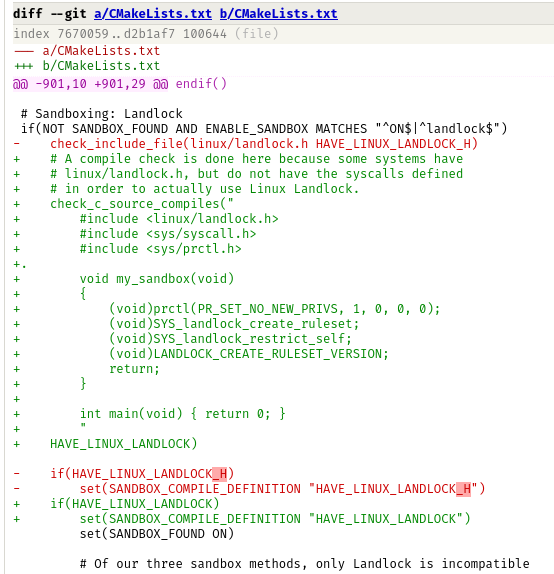I have been thinking about self-hosting my personal photos on my linux server. After the recent backdoor was detected I’m more hesitant to do so especially because i’m no security expert and don’t have the time and knowledge to audit my server. All I’ve done so far is disabling password logins and changing the ssh port. I’m wondering if there are more backdoors and if new ones are made I can’t respond in time. Appreciate your thoughts on this for an ordinary user.
Cheeky answer:

Actual answer:
Theoretically anyway, open source software’s guarantee of “no backdoor” is that the code is auditable, and you could study it and know if it has any holes and where. Of course, that presumes that you have the knowledge AND time to actually go and study thousands of lines of code. Unrealistic.
Slightly less guaranteed but still good enough to calm my mind, is the idea that there is a whole-ass community of people who do know their shit and who are constantly checking this.Do note that like. Closed source software is known to be backdoored, only, the backdoors are mostly meant for either the owners of the software (check the fine print folks) or worse, the governments.
The biggest thing that you should note is that: It is unlikely that you (or I or most of the people here) are interesting enough that anyone will actually exploit those vulnerabilities to personally fuck you over. Your photos aren’t interesting enough except as part of a mass database (which is why Google/Facebook want them). Same for your personal work data and shit.
Unless those backdoors could be used to turn your machine into a zombie for some money-making scheme (crypto or whatever) OR you’re connected to people in power OR you personally piss off someone who is a hacker – it is very unlikely you’ll get screwed over due to those vulnerabilities :P
Just a point to add: this backdoor was (likely) planned years in advance; it took ONE guy a couple weeks (after the malicious code was released) to find it because he had nothing else going on that evening.
I’m relatively confident that the FOSS community has enough of that type of person that if there are more incidents like this one, there’s a decent chance it’ll be found quickly, especially now that this has happened and gotten so much attention.
Even better: there are also backdoors in closed-source software that will never be found. There may be fewer backdoors inserted, but the ones that get in there are far more likely to stay undiscovered.
Afaik, most phones are backdoored that can be abused using tools like “pegasus” which led to a huge indignation in Hungary. I don’t belive PCs are exceptions. Intel ME is a proprietary software inside the CPU, often considered as a backdoor in Intel. AMD isn’t an exception. It’s even weirder that Intel produces chips with ME disabled for governments only.
They are not produced for governments only, almost every consumer-grade CPU can have its ME disabled or at least scuttled, thanks to efforts like me_cleaner!
Have you tried it?
We dont.
I’m pretty sure most closed source software is already backdoored.
It’s a feature!
How do you know there isn’t a logic bug that spills server secrets through an uninitialized buffer? How do you know there isn’t an enterprise login token signing key that accidentally works for any account in-or-out of that enterprise (hard mode: logging costs more than your org makes all year)? How do you know that your processor doesn’t leak information across security contexts? How do you know that your NAS appliance doesn’t have a master login?
This was a really, really close one that was averted by two things. A total fucking nerd looked way too hard into a trivial performance problem, and saw something a bit hinky. And, just as importantly, the systemd devs had no idea that anything was going on, but somebody got an itchy feeling about the size of systemd’s dependencies and decided to clean it up. This completely blew up the attacker’s timetable. Jia Tan had to ship too fast, with code that wasn’t quite bulletproof (5.6.0 is what was detected, 5.6.1 would have gotten away with it).

In the coming weeks, you will know if this attacker recycled any techniques in other attacks. People have furiously ripped this attack apart, and are on the hunt for anything else like it out there. If Jia has other naughty projects out here and didn’t make them 100% from scratch, everything is going to get burned.
I think the best assurance is - even spies have to obey certain realities about what they do. Developing this backdoor costs money and manpower (but we don’t care about the money, we can just print more lol). If you’re a spy, you want to know somebody else’s secrets. But what you really want, what makes those secrets really valuable, is if the other guy thinks that their secret is still a secret. You can use this tool too much, and at some point it’s going to “break”. It’s going to get caught in the act, or somebody is going to connect enough dots to realize that their software is acting wrong, or some other spying-operational failure. Unlike any other piece of software, this espionage software wears out. If you keep on using it until it “breaks”, you don’t just lose the ability to steal future secrets. Anybody that you already stole secrets from gets to find out that “their secrets are no longer secret”, too.
Anyways, I think that the “I know, and you don’t know that I know” aspect of espionage is one of those things that makes spooks, even when they have a God Exploit, be very cautious about where they use it. So, this isn’t the sort of thing that you’re likely to see.
What you will see is the “commercial” world of cyberattacks, which is just an endless deluge of cryptolockers until the end of time.
deleted by creator
We don’t.
“We don’t” is the short answer. It’s unfortunate, but true.
I do IT security for a living. It is quite complicated but not unrealistic for you to DIY.
Do a risk assessment first off - how important is your data to you and a hostile someone else? Outputs from the risk assessment might be fixing up backups first. Think about which data might be attractive to someone else and what you do not want to lose. Your photos are probably irreplaceable and your password spreadsheet should probably be a Keepass database. This is personal stuff, work out what is important.
After you’ve thought about what is important, then you start to look at technologies.
Decide how you need to access your data, when off site. I’ll give you a clue: VPN always until you feel proficient to expose your services directly on the internet. IPSEC or OpenVPN or whatevs.
After sorting all that out, why not look into monitoring?
Fun fact, you can use let’s encrypt certs on a internal environment. All you need is a domain.
I do use it quite a lot. The pfSense package for ACME can run scripts, which might use scp. Modern Windows boxes can run OpenSSH daemons and obviously, all Unix boxes can too. They all have systems like Task Scheduler or cron to pick up the certs and deploy them.
Just be aware that its an information leakage (all your internal DNS names will be public)
…which shouldn’t be an issue in any way. For extra obscurity (and convenience) you can use wildcard certs, too.
Are wildcard certs supported by LE yet?
Have been for a long time. You just have to use the DNS validation. But you should do that (and it’s easy) if you want to manage “internal” domains anyway.
Oh, yeah, idk. Giving API access to a system to modify DNS is too risky. Or is there some provider you recommend with a granular API that only gives the keys permission to modify TXT and .well-known (eg so it can’t change SPF TXT records or, of course, any A records, etc)
What you can (and absolutely should) do is DNS delegation. On your main domain you delegate the
_acme-challenge.subdomains with NS records to your DNS server that will do cert generation (and cert generation only). You probably want to run Bind there (since it has decent and fast remote access for changing records and other existing solutions). You can still split it with separate keys into different zones (I would suggest one key per certificate, and splitting certificates by where/how they will be used).You don’t even need to allow remote access beyond the DNS responses if you don’t want to, and that server doesn’t have anything to do with anything else in your infrastructure.
The best you can do is use OSS software that has been battle tested. Stuff like OpenSSH and OpenVPN are very unlikely to have backdoors or major vulnerabilities currently being exploited. If you don’t trust something to not be vulnerable, you’re best to put it behind a more robust layer of authentication and access it only by those means.
How do you know what you don’t know?
That’s basically what you’re asking. If you have an answer to that general question, it will answer your specific question.
Anti Commercial AI thingy
Ah shit we are back to “Ken Thompson Compiler Hack” again
for those unfamiliar: Reflections on trusting trust by Ken Thompson
Even if there are nation state level backdoors, your personal server is not a valuable enough target to risk exposing them. Just use common sense, unattended-upgrades, and don’t worry too much about it.
This was likely a state-sponsored attack. If your SSH isn’t exposed to the internet this probably wouldn’t have effected you. Also most people run stable distros like Debian on their server, and this particular vulnerability never made it to the stable branch. I would guess that most of the computers you have ever used have backdoors. Even if you run Linux (which may itself have some) you might still have a proprietary UEFI on your motherboard. Something like xz wouldn’t effect you because no government really cares what’s on your server. Smaller attacks can be avoided through common sense. Some people will expose services that require zero authentication to the internet. Follow basic best practices and you will probably be fine.
Edit: Also remember, google photos once flagged a picture of a child that the child’s father had taken for medical reasons as abuse, so self-hosted may not be completely private or secure, but it’s better than the alternative.
Reading the source code for everything running on your machine and then never updating is the only way to be absolutely 100% sure.
Even with that you will miss something
This is a sliver of one patch, there is a bug here that disabled a build tool that breaks the attack. Can you find it?

Maybe
Dot after include















